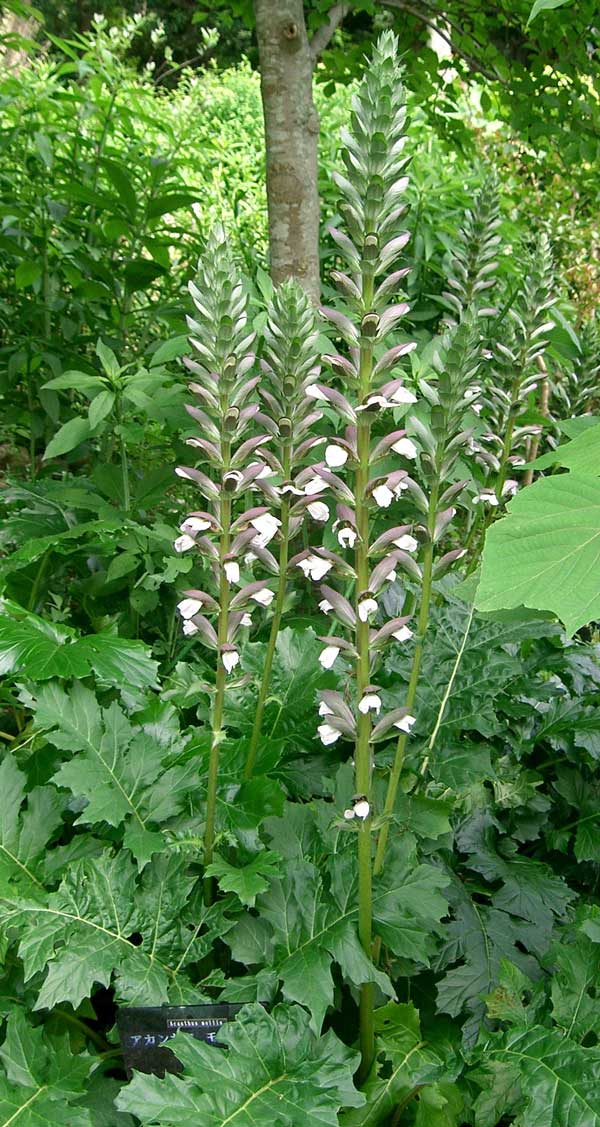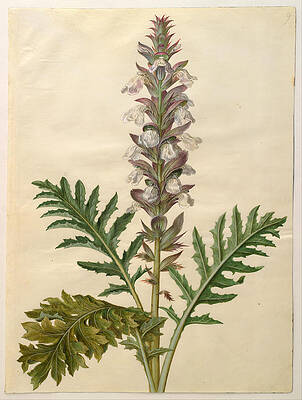
Acanthus mollis (*)
Classification System: APG IV
Superregnum: Eukaryota
Regnum: Plantae
Cladus: Angiosperms
Cladus: Eudicots
Cladus: Core eudicots
Cladus: Asterids
Cladus: Lamiids
Ordo: Lamiales
Familia: Acanthaceae
Subfamilia: Acanthoideae
Tribus: Acantheae
Subtribus: Acanthinae
Genus: Acanthus
Species: Acanthus mollis
Name
Acanthus mollis L., Sp. Pl. 2: 639 ("939") (1753).
Synonyms
Heterotypic
Acanthus latifolius Goeze, Gard. Chron. 1867: 856 (1867).
Acanthus longifolius Poir. in J.B.A.M.de Lamarck, Encycl., Suppl. 1: 88 (1810).
Acanthus lusitanicus hort., Gard. Chron. 1867: 903 (1867).
Acanthus mollis subsp. platyphyllus Murb., Acta Univ. Lund., 2, 1(4): 64 (1905).
Acanthus niger Mill., Gard. Dict. ed. 8: n.º 2 (1768).
Acanthus spinosissimus Host, Fl. Austriaca 2: 218 (1831)
Acanthus spinulosus Host, Fl. Austriaca 2: 217 (1831).
Homonyms
Acanthus mollis Riedel ex Nees = Acanthus spinosus L.
Acanthus mollis, Johannes Simon Holtzbecher
Distribution
Native distribution areas:
Continental: Europe
Regional: Northern Europe
Great Britain (introduced)
Regional: Southwestern Europe
Baleares (Mallorca, Menorca), Corse, France, Portugal (introduced), Sardegna, Spain (introduced).
Regional: Southeastern Europe
Greece (introduced), Italy, Kriti (introduced), Sicilia (Sicily, Malta), Turkey-in-Europe, Yugoslavia (Croatia)
Continental: Africa
Regional: Northern Africa
Algeria, Morocco, Tunisia:
Regional: Macaronesia (introduced)
Azores (Faial, Flores, Pico, Sao Miguel, Terceira), Canary Islands (Gran Canaria, Gomera, Tenerife), Madeira (Madeira).
Continental: Asia-Temperate
Regional: Western Asia
East Aegean Islands (introduced), Lebanon-Syria (Lebanon, Syria), Turkey (doubtfully native).
Continental: Asia-Tropical (introduced)
Regional: Indian Subcontinent
India (Tamil Nadu).
Continental: Australasia (introduced)
Regional: Australia
Queensland, South Australia.
Regional: New Zealand
Chatham Islands, New Zealand North, New Zealand South.
Continental: Northern America (introduced)
Regional: Southwestern U.S.A.
California.
Continental: Southern America (introduced)
Regional: Central America
Costa Rica.
Regional: Northern South America
Venezuela.
Regional: Western South America
Bolivia, Colombia, Ecuador.
References: Brummitt, R.K. 2001. TDWG – World Geographical Scheme for Recording Plant Distributions, 2nd Edition
References
Linnaeus, C. 1753. Species Plantarum. Tomus II: 639. Reference page.
Links
Hassler, M. 2018. Acanthus mollis. World Plants: Synonymic Checklists of the Vascular Plants of the World In: Roskovh, Y., Abucay, L., Orrell, T., Nicolson, D., Bailly, N., Kirk, P., Bourgoin, T., DeWalt, R.E., Decock, W., De Wever, A., Nieukerken, E. van, Zarucchi, J. & Penev, L., eds. 2018. Species 2000 & ITIS Catalogue of Life. Published online. Accessed: 2018 Jun. 08. Reference page.
Govaerts, R. et al. 2020. Acanthus mollis in Kew Science Plants of the World online. The Board of Trustees of the Royal Botanic Gardens, Kew. Published online. Accessed: 2020 Oct 29. Reference page.
Euro+Med 2006 onwards: Acanthus mollis in Euro+Med PlantBase – the information resource for Euro-Mediterranean plant diversity. Published online. Accessed: 2020 Oct 29.
Tela Botanica (ed.) 2000 onwards: Tela Botanica. Le réseau de la botanique francophone. eFlore. Acanthus mollis. Association Tela Botanica, Montpellier, France. Accessed: 2020 Oct 29.
International Plant Names Index. 2018. Acanthus mollis. Published online. Accessed: Jun. 08 2018.
The Plant List 2013. Acanthus mollis in The Plant List Version 1.1. Published online. Accessed: 2018 Jun. 08.
Tropicos.org 2018. Acanthus mollis. Missouri Botanical Garden. Published online. Accessed: 08 Jun. 2018.
USDA, ARS, Germplasm Resources Information Network. Acanthus mollis in the Germplasm Resources Information Network (GRIN), U.S. Department of Agriculture Agricultural Research Service. Accessed: 09-Oct-10.
USDA NRCS PLANTS Profile
Vernacular names
català: Acant
corsu: Acantu
dansk: Blød Akantus
Deutsch: Weicher Akanthus
English: Bear´s breech
español: Acanto
suomi: Kreikanakantti
français: Acanthe à feuilles molles
galego: Acanto
magyar: Hosszú levelű medveköröm
italiano: Acanto
日本語: アカンサス
polski: Akant miękki
sardu: Acantu
svenska: Mjukakantus
Acanthus mollis, commonly known as bear's breeches, sea dock,[2] bear's foot plant, sea holly, gator plant or oyster plant,[3] is a species of plant in the family Acanthaceae and is native to the Mediterranean region. It is a leafy, clump-forming perennial herb, with a rosette of relatively large, lobed or toothed leaves, and purplish and white flowers on an erect spike.
Description
Acanthus mollis is a leafy, clump-forming perennial herb with tuberous roots. It has a basal rosette of dark glossy green, lobed or divided, glabrous leaves 50 cm (20 in) long and 30 cm (12 in) wide on a petiole 20–30 cm (7.9–11.8 in) long. The flowers are borne on an erect spike up to 200 cm (79 in) tall emerging from the leaf rosette. The sepals are purplish and function as the upper and lower lips of the petals, the upper lip about 4 cm (1.6 in) long and the lower lip 3 cm (1.2 in) long. The petals are about 4–4.5 cm (1.6–1.8 in) long and form a tube with a ring of hairs where the stamens are attached. Flowering occurs in summer and the fruit is a sharply-pointed capsule about 2 cm (0.79 in) long containing one or two brown seeds about 14 mm (0.55 in) long and 8 mm (0.31 in) wide.[4][5]
Taxonomy and naming
Acanthus mollis was first formally described in 1753 by Carl Linnaeus in his book Species Plantarum.[6] The name of the genus derives from the Greek name of the plant ἄκανθος ákanthos; it was imitated in Corinthian capitals. This ἄκανθος ákanthos is related to ἄκανθα ákantha meaning "thorn" referring to the thorn-bearing sepals, or any thorny or prickly plant in Greek.[7][8][9][10][11] The Latin name of the species, mollis meaning "soft, smooth", refers to the texture of the leaves.[12]
Distribution and ecology
Although native to the eastern and central Mediterranean,[13] Acanthus mollis has spread throughout much of western Europe and certain parts of the Americas, Australia and New Zealand, where it is regarded as invasive.[5][14][15]
Acanthus mollis is entomophilous, pollinated only by bees or bumble bees large enough to force their way between the upper sepal and the lower, so that they can reach the nectar at the bottom of the tube.
Use in horticulture
These plants are usually propagated from tubers and tend to form large, localized clumps which can survive for several decades and look statuesque when well-grown, but its suitability as a garden plant is lessened on account of its invasive nature (new plants are produced readily both from seed and portions of root) and its susceptibility to attacks from slugs and snails.[16]
Cultural depiction
The shape of the leaf of this plant inspired the ancient Greek sculptor Callimachus (5th c. BCE) to model the capital of the Corinthian column. Since then, the Corinthian order column has been used extensively in Greco-Roman[17] and Classical architecture. For centuries, stone or bronze stylized versions of acanthus leaves have appeared as acanthus decorations on certain styles of architecture and furniture.[18] Virgil described Helen of Troy as wearing a dress embroidered with Acanthus leaves.[19]
References
"The Plant List: A Working List of All Plant Species". Retrieved 18 December 2014.
"Acanthus mollis". Germplasm Resources Information Network (GRIN). Agricultural Research Service (ARS), United States Department of Agriculture (USDA). Retrieved 18 December 2014.
"Weed Information Sheet".
Conn, Barry J. "Acanthus mollis". Royal Botanic Garden Sydney. Retrieved 8 October 2020.
"Acanthus mollis". New Zealand Plant Conservation Network. Retrieved 8 October 2020.
Linnaeus, Carl (1753). Species Plantarum. Berlin: Junk, 1908. p. 639. Retrieved 8 October 2020.
ἄκανθος
ἄκανθα. Liddell, Henry George; Scott, Robert; A Greek–English Lexicon at the Perseus Project
"άκανθος".
"Dictionary of Standard Modern Greek" άκανθος (in Greek). Centre for the Greek Language.
Harper, Douglas. "acanthus". Online Etymology Dictionary.
mollis. Charlton T. Lewis and Charles Short. A Latin Dictionary on Perseus Project.
"Acanthus mollis" (PDF). Flora Iberica. Retrieved 29 April 2022.
Weeds of Australia, Biosecurity Queensland edition: Bear's breeches, Acanthus mollis Archived April 2, 2015, at the Wayback Machine
"Acanthus mollis L.; Sp. Pl.: 939 [639] (1753)". www.worldplants.de. Retrieved 29 April 2022.
"Acanthus mollis". Missouri Botanic Garden. Retrieved 8 October 2020.
and has been described by Vitruvius. On Architecture. Book IV.
Lewis, Philippa; Darley, Gillian (1986). Dictionary of Ornament. New York: Pantheon. p. not cited. ISBN 9780394509310.
"How to grow: Acanthus".
Retrieved from "http://en.wikipedia.org/"
All text is available under the terms of the GNU Free Documentation License


